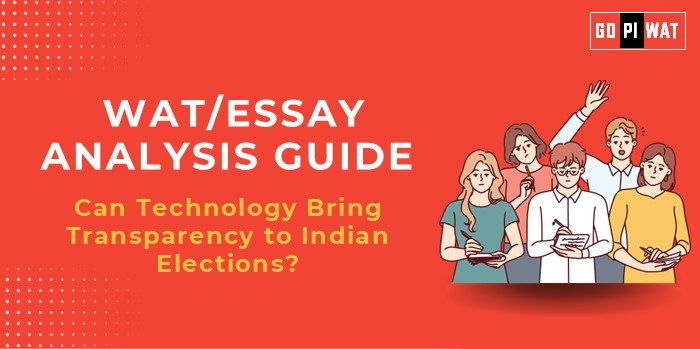🖋️ WAT/Essay Analysis Guide: Can Technology Bring Transparency to Indian Elections?
🌟 Understanding the Topic’s Importance
The potential of technology to enhance transparency in Indian elections ties into the core principles of democracy. Transparent electoral processes ensure fairness, boost public trust, and strengthen governance. India, the world’s largest democracy, has pioneered technological adoption in voting, but challenges persist in ensuring its universality and trustworthiness. This topic explores the role of innovation, ethical use of technology, and inclusivity in electoral reforms.
📝 Effective Planning and Writing
- Time Allocation:
- ⏳ Planning: 5 minutes
- ✍️ Writing: 20 minutes
- 🔍 Reviewing: 5 minutes
- Preparation Tips:
- 📊 Research recent technological advancements in Indian elections, such as EVMs, VVPATs, and digital voter management systems.
- 🌍 Compare with global benchmarks like Estonia’s internet voting system and Brazil’s electronic voting model.
🎯 Structuring the Essay
📜 Introduction Techniques
- Contrast Approach:
“India has been a global leader in adopting electronic voting machines, yet the digital divide and cybersecurity concerns challenge the promise of transparent elections.”
- Solution-Based Approach:
“Can blockchain technology address electoral transparency issues? As India continues its technological journey, such innovations could redefine its electoral processes.”
🔍 Body Paragraphs
- Achievements:
- ✅ Efficiency: EVMs reduced human errors and enabled faster counting.
- 📱 Empowering Citizens: Apps like cVIGIL allow real-time reporting of electoral violations.
- 📜 Transparency: VVPATs ensure voters can verify their votes.
- 📈 Data: Over 11.5 billion monthly digital transactions (NPCI, 2024) demonstrate technology’s scalability and reliability.
- Challenges:
- ⚠️ Cybersecurity Threats: Concerns about misinformation and EVM tampering.
- 🌐 Digital Divide: Only 20% of rural households have stable internet connectivity, raising concerns about equitable access.
- 🤔 Public Trust: Misinformation campaigns risk undermining faith in technology-enabled processes.
- Future Outlook:
- ✔️ Blockchain Integration: Propose blockchain for secure, tamper-proof voting records.
- 📖 Education: Bridge digital literacy gaps, especially in rural areas, through training programs.
- 🤝 Collaboration: Adopt international best practices for cybersecurity and electoral transparency.
💡 Concluding Effectively
- Balanced Perspective:
“While technology offers a transformative path to electoral transparency, its ultimate success depends on addressing inequities and enhancing cybersecurity frameworks to foster trust among voters.”
- Global Comparison:
“India’s leadership in EVM adoption sets a global example, but incorporating blockchain, as seen in Estonia, could further reinforce its electoral integrity.”
📚 Sample Short Essays (100 words each)
- Balanced Perspective:
“Technology has become a cornerstone of modern elections, reducing errors and empowering citizens through tools like VVPATs and cVIGIL. However, challenges such as cybersecurity threats and unequal internet access remain significant barriers to achieving full transparency. India must innovate while addressing these gaps, ensuring its electoral processes are inclusive, secure, and trusted by all.”
- Solution-Oriented:
“Blockchain technology holds immense potential to enhance electoral transparency by creating immutable, tamper-proof voting records. Alongside this, voter education programs can bridge the trust gap, empowering citizens to participate confidently. Adopting such measures can ensure India’s elections are not only technologically advanced but also universally trusted.”
- Global Comparison:
“While Estonia’s internet voting model demonstrates the potential of technology to enhance electoral transparency, India faces unique challenges due to its scale and digital divide. By prioritizing localized solutions such as mobile-based voting and expanding rural internet connectivity, India can set a global standard for technology-driven democratic processes.”


